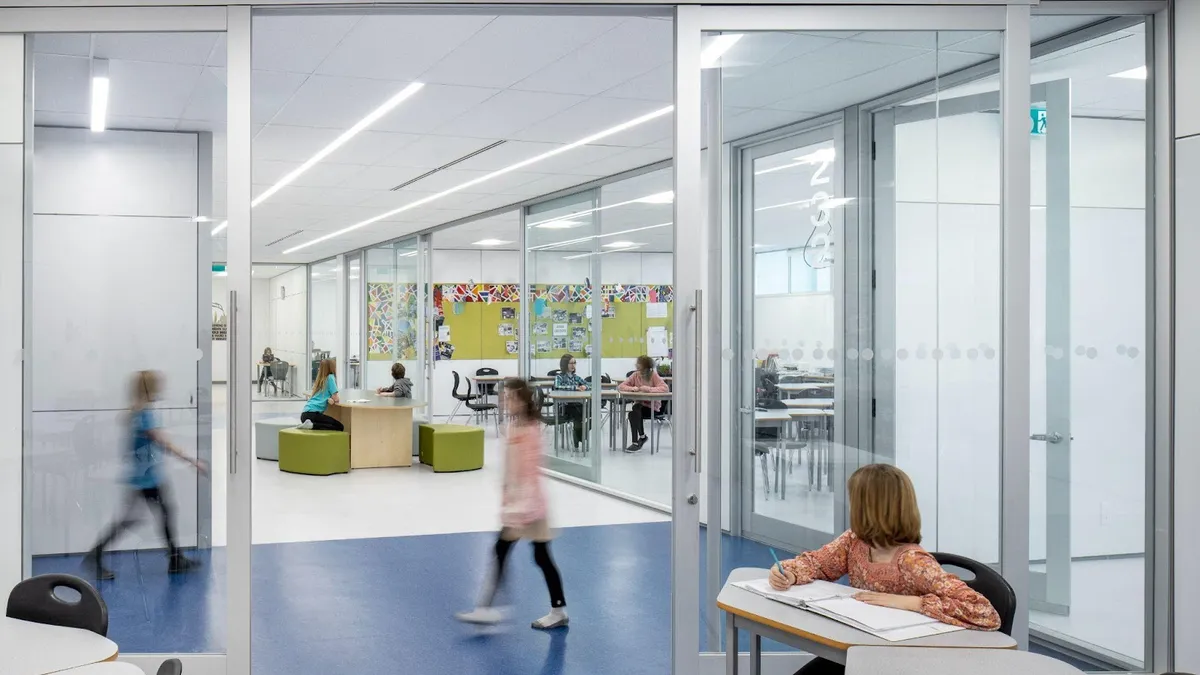"I have to walk down a gauntlet in front of everybody else. They know I'm going to my counselor, and it prevents me from wanting to go."
A struggling high school student describes to Victoria Bergsagel what it feels like as they walk the hallway lined with lockers and harsh fluorescent lighting.
The former educator turned founder and director of Architects of Achievement has heard more of these stories than she can count. That's why she and her team specialize in creating educational spaces that meet the diverse needs of all students — but especially those who've experienced trauma.
And the volume of young people who have gone through a traumatic event in childhood is agonizing.
A 2020 study by BMC Public Health found that a staggering 57.8% of American adults experienced at least one adverse childhood experience (ACE), with 21.5% experiencing three or more. ACEs aren't minor challenges either. They include physical, emotional or sexual abuse, domestic violence, mental illness, substance abuse or incarceration affecting someone in their household, as well as parents separating or divorcing.
Bergsagel calls traditional school design a "cells and bell model" — yes, she's referring to prison cells — where the effects of trauma can turn long hallways into terrifying highways with no "off-ramp" and drive students into bathroom stalls as their only refuge.
This is where trauma-informed design comes in.
With trauma-informed design, architects and interior designers integrate the principles of trauma-informed care into the design of a space. The goal is to create space that is welcoming, safe, and promotes both healing and well-being.
The innovative design approach reshapes learning environments, helping students regulate emotional triggers as they arise, which then improves their learning experience and outcomes as well.
Of course, effective educational practices and caring teachers are key to assisting students with trauma-induced anxiety, stress and behavioral challenges. But space has an integral part to play too, Bergsagel says.
One of the biggest problems with standard approaches to educational design (for both K-12 and university and college settings), is students are not given the option to address their emotions in the way that best suits them. For instance they may need to retreat to a safe space or move to a different environment in order to participate, she explains.
"If we give them choice, then they have more agency." And that's the opportunity they need to focus on learning and excel.
Empower students to choose the level of engagement they need to thrive
"First you need to enter the school."
Bergsagel paints a vivid picture of what students might experience in a trauma-informed environment, from the moment they step foot through the front doors.
They are warmly greeted by someone behind a desk, not a tall, daunting counter. For younger kids, perhaps there are features such as a rocking chair and a bookcase inviting them into the space.
As students make their way through the school, there are fewer long, foreboding hallways or fishbowl scenarios — like in a traditional cafeteria, for instance — and more curvilinear spaces that offer visibility of who is coming and going, as well as areas of refuge, such as nooks and balconies.
When it comes to layout, "it's becoming increasingly common to have clusters of learning." Bergsagel says these spaces will place a group of classrooms around a gathering area so occupants have alternate spaces to be, including project-based space.
As for the classrooms themselves, they might feature a "peace corner" where students can take a breath when they need to, use fidget materials, read a book or just sit for a few moments to gather themselves. There's soothing color schemes, as well as biophilic decor and materials, which are proven to enhance comfort and reduce stress. Maybe the space also has big barn or garage doors, providing access to the outside world.
A trauma-informed design approach embraces "layers of space" that enable young people to choose the level of engagement they need at any given time, Bergsagel explains.
These layers are a mix of larger spaces for community engagement, medium-sized spaces for group discussion, and smaller, safe spaces for intimate connection or isolation.
Permission granted by Project: Studio Hub Architects. Image: Kevin Jamieson
Trauma-informed design and construction is flexible in the moment and easily adaptable in the future
Flexibility is key when creating layers of space for students.
For example, if teachers can turn a small- or medium-sized area into a larger space by pulling back a moveable wall, they can facilitate collaboration. Or vice versa if more privacy is required, says Bergsagel.
Flexible furniture matters too, she says. Think of chairs on wheels, stools and café tables that can easily be moved into different configurations, supporting a variety of learning activities. They are a significant improvement on the old-school chairs with attached desks that Bergsagel describes as "one-armed bandits."
While flexibility is all about what teachers and students can do to immediately adjust their environment, adaptability makes future changes easier to accomplish.
Bergsagel shares an example: if you strategically decide where to put load-bearing walls that contain electrical and plumbing infrastructure, then you leave other connecting walls free to be removed, in whole or in part, for new space configurations in the future.
Weaving flexibility and adaptability into a trauma-informed environment supports the key goal of providing students with choice of location, noise and lighting levels, and even the type of furniture they are most comfortable with — which then inspires better attention, learning and memory, Bergsagel says.
While trauma-informed design creates space that helps ameliorate some of the mental and physical challenges children and young adults with trauma might experience throughout their day, it ultimately benefits all students.
"Students spend a good majority of their day in school, so they should be safe places, caring places, places they can really shine," says Bergsagel. She often takes clients to explore fabulous work environments that are inspiring and flexible, asking, "If adults get this, why can't kids have something similar?"






